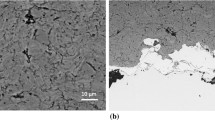Abstract
An investigation into the influence of load and surface finish on the reciprocating corrosive wear of grey cast iron in oil-10 vol % sulphuric acid mixtures has been undertaken with particular respect to the contact between cylinder-lining and piston-ring materials from marine diesel engines. In mixtures containing acid of 10 vol% concentration, under loads of 1.5 to 3.5 kg, the hard-phase phosphide eutectic/alloy carbide material in the cast irons was able to support the load and aid in the retention of an oil film during sliding. However, at a load of 4 kg the hard-phase material was able to penetrate the oil film more effectively and contact the countersurface for long periods, giving considerably increased wear rates. In mixtures containing acid of 40% concentration, the wear rates were less than those of 10% concentration, due to formation of adherent, wear-protective corrosion-product films. These were particularly effective at loads of 1.5 to 2.0 kg, while at 2.5 to 4.0 kg such films were unable to be sustained on the hard-phase regions and wear rates were increased to some extent, although were still much less than in the 10% acid concentration mixture. During sliding in mixtures containing acid of 40% concentration, development of a wear-protective film was influenced very markedly by the surface finish of the cast-iron specimens. Corrosion-product films were able to develop more easily on rough surfaces (120 grit) than on smooth surfaces (1 μm), while hydrodynamic oil films could develop more easily on smooth surfaces. The overall result was that the wear rate increased with decreasing surface roughness from 120 grit to a maximum at an intermediate value (800 grit), and then decreased with further decrease in roughness to 1 μm.
Similar content being viewed by others
References
T. S. Eyre,Tribol. Int. 9 (1976) 203.
J. J. Broenze andA. Wilson,Proc. Inst. Mech. Eng. 160 (1949) 133.
R. P. Burtenshaw andL. R. C. Lilly,Trans. Inst. Mar. Eng. 84 (1972) 89.
D. H. Golothan,Indust. Lub. Tribol. 28 (1978) 128.
I. G. Simonetti,Corros. Tech. 7 (1960) 315.
R. S. Montgomery,Wear 14 (1969) 99.
A. G. Macdonald andF. H. Stott,Corros. Sci., in press.
F. H. Stott andA. G. Macdonald,Wear., in press.
A. G. Macdonald andF. H. Stott,React. Solids., in press
A. G. Macdonald, PhD thesis, University of Manchester (1982).
F. H. Stott, J. Glascott andG. C. Wood,J. Phys. D: Appl. Phys. 18 (1985) 541.
Author information
Authors and Affiliations
Rights and permissions
About this article
Cite this article
Macdonald, A.G., Stott, F.H. The influence of load and surface treatment on the corrosive wear of cast iron in oil-sulphuric acid environments. J Mater Sci 23, 629–636 (1988). https://doi.org/10.1007/BF01174697
Received:
Accepted:
Issue Date:
DOI: https://doi.org/10.1007/BF01174697




